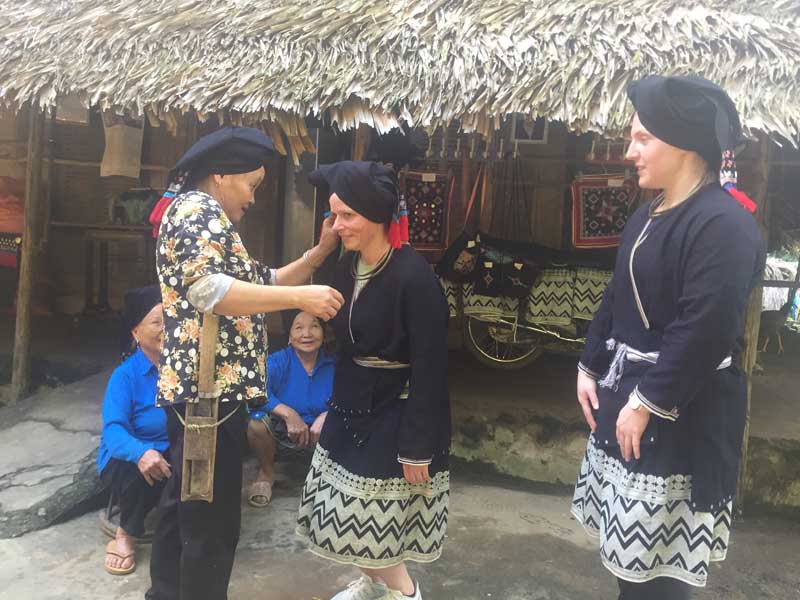
(HBO) - Da Bac district has rolled out a host of measures to conserve and promote traditional cultural values in accordance with Resolution No.5 at the eighth session of the 12th Party Central Committee on the building and development of the Vietnamese culture.
 Foreign
visitors explore traditional culture of the Dao ethnic group in Sung hamlet,
Cao Son commune (Da Bac district).
Foreign
visitors explore traditional culture of the Dao ethnic group in Sung hamlet,
Cao Son commune (Da Bac district).
Da Bac, a mountainous district of Hoa Binh,
is home to many ethnic groups, primarily Tay, Muong, Kinh, and Dao. Each group
has its own culture and traditional traits.
Vice head of the district’s office on culture
and sport Bui Hong Anh said that the conservation and development of culture is
viewed as a key task which, in turn, will contribute to the dissemination and
effective implementation of policies and regulations of the Party and State in
enhancing the national unity and economic development, raising the knowledge
standards of people and cultural identity conservation.
The district has over the past years
carried out activities to call on local people to protect traditional cultural
values in line with building a civilised lifestyle at residential areas. Due
attention has been paid to the conservation of intangible heritage and recovery
of local language, traditional costume, festivals, folk melodies, games,
cuisine, and architecture and craft, among others. Mechanisms and policies have
been mulled over to uphold and promote cultural values of the local ethnic
groups.
By now, many hamlets and residential areas in
Hien Luong, Muong Chieng, Tien Phong, Cao Son and Nanh Nghe have launched
community-based tourism in keeping with promoting traditional cultural values.
Stilt houses with wooden floor and palm leaf
roof of ethnic minority groups are maintained, and so are the annual festivals
such as the new year celebration of Dao people in Cao Son and Thac Bo shrine
festival in Vay Nua.
Training courses on skills for tangible and
intangible heritage conservation have been held, particularly ethnic language
classes in Cao Son and Vay Nua communes.
As traditional cultural values of ethnic
people have been protected and bolstered, they have turned into typical tourism
products in tandem with the district’s tourism development./.
A diverse chain of eco-tourism and resort destinations concentrated in Hoa Binh city and the districts of Tan Lac, Da Bac, and Luong Son… Along with the launch of several key high-quality resort tourism projects, these developments have reshaped the landscape and enhanced the appeal of Hoa Binh as a travel destination.
Boasting diverse terrain, a mild climate, and rich natural resources, Cao Phong district is increasingly asserting its place on Vietnam’s tourism map, attracting both domestic and foreign visitors. The district is renowned for its stunning landscapes, majestic mountains, a crystal-clear hydropower lake, and the unique cultural identity of local ethnic groups.
With its pristine landscapes, unique cultural heritage of Muong ethnic minority, and an expanding range of visitor experiences, Tan Lac district of Hoa Binh has fast become a captivating destination for both domestic and international tourists.
Until now, Sung village in Cao Son commune, Da Bac district remains the only Dao ethnic community in Hoa Binh province to develop a community-based tourism model. Beyond its untouched natural landscapes, cultural identity serves as the cornerstone attraction for visitors.
Alongside the diverse cultural identities of the Kinh, Muong, Tay, Thai, Dao, and Mong ethnic people, Hoa Binh province is also renowned as the "capital" of the northwestern Vietnamese cuisine, offering unique and distinctive dishes. At festivals, during Lunar New Year (Tet), or on significant family or community occasions, special dishes are prepared, leaving a lasting impression on visitors.
A Phong Linh (Yellow Tabebuia) flower garden in Thang village, Thach Yen commune, Cao Phong district is currently in full bloom, drawing a large number of visitors.



 Foreign
visitors explore traditional culture of the Dao ethnic group in Sung hamlet,
Cao Son commune (Da Bac district).
Foreign
visitors explore traditional culture of the Dao ethnic group in Sung hamlet,
Cao Son commune (Da Bac district).